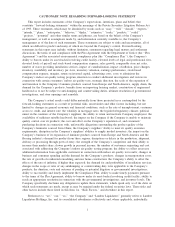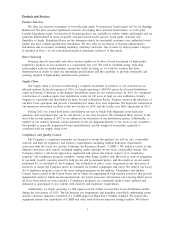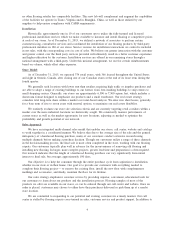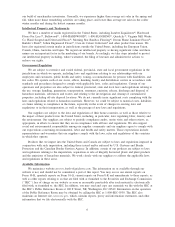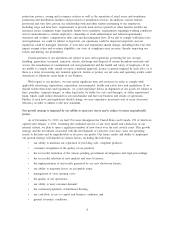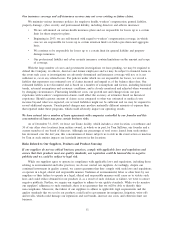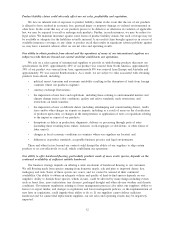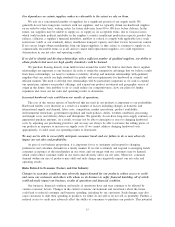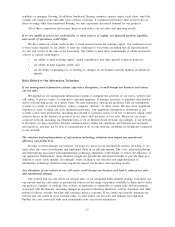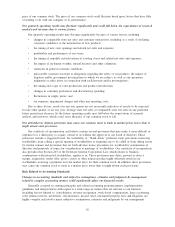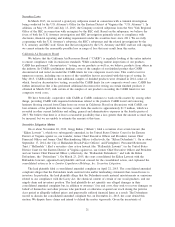Lumber Liquidators 2015 Annual Report Download - page 21
Download and view the complete annual report
Please find page 21 of the 2015 Lumber Liquidators annual report below. You can navigate through the pages in the report by either clicking on the pages listed below, or by using the keyword search tool below to find specific information within the annual report.Our insurance coverage and self-insurance reserves may not cover existing or future claims.
We maintain various insurance policies for employee health, workers’ compensation, general liability,
property damage, cyber security and professional liability, including directors and officers insurance:
• We are self-insured on certain health insurance plans and are responsible for losses up to a certain
limit for these respective plans.
• Beginning in 2013, we are self-insured with regard to workers’ compensation coverage, in which
case we are responsible for losses up to certain retention limits on both a per-claim and aggregate
basis.
• We continue to be responsible for losses up to a certain limit for general liability and property
damage insurance.
• Our professional liability and cyber security insurance contain limitations on the amount and scope
of coverage.
With the large number of cases and government investigations we have pending, we may be required to
defend the Company, its officers, directors and former employees and we may be subject to financial harm in
the event such cases or investigations are adversely determined and insurance coverage will not, or is not
sufficient to, cover any related losses. For policies under which we are responsible for losses, we record a
liability that represents our estimated cost of claims incurred and unpaid as of the balance sheet date. Our
estimated liability is not discounted and is based on a number of assumptions and factors, including historical
trends, actuarial assumptions and economic conditions, and is closely monitored and adjusted when warranted
by changing circumstances. Fluctuating healthcare costs, our growth rate and changes from our past
experience with workers’ compensation claims could affect the accuracy of estimates based on historical
experience. Should a greater amount of claims occur compared to what was estimated or medical costs
increase beyond what was expected, our accrued liabilities might not be sufficient and we may be required to
record additional expense. Unanticipated changes may produce materially different amounts of expense than
that reported under these programs, which could adversely impact our operating results.
We have entered into a number of lease agreements with companies controlled by our founder and this
concentration of leases may pose certain business risks.
As of December 31, 2015, we lease our Toano facility, which includes a store location, a warehouse and
30 of our other store locations from entities owned, in whole or in part, by Tom Sullivan, our founder and a
current member of our board of directors. Although our percentage of total stores leased from such entities
has decreased over the last year, this concentration of leases subjects us to risk in the event action or inaction
by Tom or such entities impacts our leasehold interests in the locations.
Risks Related to Our Suppliers, Products and Product Sourcing
If our suppliers do not use ethical business practices, comply with applicable laws and regulations and
ensure that their products meet our quality standards, our reputation could be harmed due to negative
publicity and we could be subject to legal risk.
While our suppliers agree to operate in compliance with applicable laws and regulations, including those
relating to environmental and labor practices, we do not control our suppliers. Accordingly, despite our
continued investment in quality control, we cannot guarantee that they comply with such laws and regulations
or operate in a legal, ethical and responsible manner. Violation of environmental, labor or other laws by our
suppliers or their failure to operate in a legal, ethical and responsible manner could cause us to violate such
laws and could reduce demand for our products if, as a result of such violation or failure, we were to attract
negative publicity. Further, we require our suppliers to adhere to our quality standards. While we do monitor
our suppliers’ adherence to such standards, there is no guarantee that we will be able to identify their
non-compliance. Moreover, the failure of our suppliers to adhere to applicable legal requirements and the
quality standards that we set for our products could lead to government investigations, litigation, write-offs
and recalls, which could damage our reputation and our brands, increase our costs, and otherwise hurt our
business.
11


